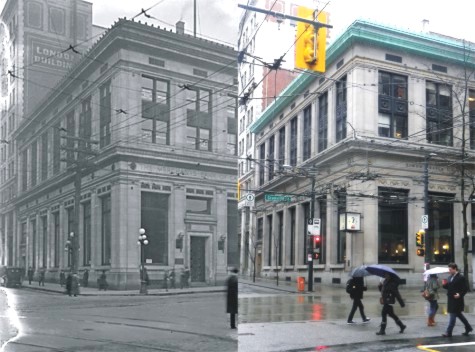
At first glance there's virtually no change between this 1922 shot of a 1915 building, and how it looked in the Vancouver rain. But looking closer, there are differences, and they reflect an evolving role for the building. In 1916 this was the new Merchants Bank, designed by Somervell and Putnam, both Americans who worked in Seattle before Vancouver. For young, recently arrived architects they picked up a remarkable set of important commissions in a very short time, and in turn delivered a set of buildings that are among the best that were built in a fiercely competitive period of growth.
The Merchants Bank was one of many trying to tempt new clients, so the building had to show style while implying solidity. The architects went with a classical theme a temple bank of three storeys (pretending to be two). By 1923 the Bank of Montreal had subsumed the Merchants Bank, and Kenneth Guscotte Rea, their architect, was given the job of doubling the size of the bank, which he achieved almost seamlessly. That's when the doorway disappears the older picture shows the entire building, the contemporary image only half the building.
By the 1990s the Bank of Montreal had no future use for the building, and it sat unwanted, and with an uncertain future. In the early 1990s Joe Segal, Vancouver businessman and property developer bought the building, donated it to Simon Fraser University, and kick-started a restoration fund that raised nearly $20 million to convert the building into the the Segal Graduate School of Business. Extensive and sensitive renovations and restoration, designed by Merrick Architecture, now see the building with a solid future to match its architectural integrity.
Source: Changing Vancouver


